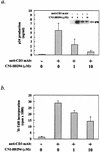CNI-H0294, a nuclear importation inhibitor of the human immunodeficiency virus type 1 genome, abrogates virus replication in infected activated peripheral blood mononuclear cells
- PMID: 9593140
- PMCID: PMC105758
- DOI: 10.1128/AAC.42.5.1133
CNI-H0294, a nuclear importation inhibitor of the human immunodeficiency virus type 1 genome, abrogates virus replication in infected activated peripheral blood mononuclear cells
Abstract
Active nuclear importation of the human immunodeficiency virus (HIV) type 1 (HIV-1) preintegration complex (PIC) is required for the productive infection of nondividing cells, but it is believed to be dispensable for the infection of proliferating cells, such as activated T lymphocytes. To investigate this question, we exploited the properties of the small arylene bis (methyl ketone) compound CNI-H0294. We have previously shown that this compound associated with the HIV-1 matrix protein nuclear localization sequence and blocked binding of the HIV-1 PIC to yeast karyopherin alpha. CNI-H0294 abrogated nuclear importation of the HIV-1 genome in macrophages and effectively inhibited infection of nondividing cells. In this study we demonstrate that CNI-H0294 inhibits binding of the HIV-1 PIC to human karyopherin alpha and reduces nuclear importation of the viral genome in primary peripheral blood mononuclear cells (PBMCs). We also demonstrate that CNI-H0294 inhibits acute infection of PBMC cultures in vitro with a primary isolate of HIV-1 and reduces virus replication and virus load in cultures of endogenously infected PBMCs from seropositive individuals. Thus, as for infection of nondividing, terminally differentiated macrophages, HIV-1 uses active nuclear importation of the virus genome to infect activated CD4+ T cells. These results support nuclear importation as a novel target and CNI-H0294 and its derivatives as novel compounds for therapeutic intervention in HIV infection and AIDS.
Figures




Similar articles
-
Critical role of reverse transcriptase in the inhibitory mechanism of CNI-H0294 on HIV-1 nuclear translocation.Proc Natl Acad Sci U S A. 1996 Oct 15;93(21):11859-64. doi: 10.1073/pnas.93.21.11859. Proc Natl Acad Sci U S A. 1996. PMID: 8876228 Free PMC article.
-
Nuclear localization signal of HIV-1 as a novel target for therapeutic intervention.Mol Med. 1995 Jan;1(2):217-30. Mol Med. 1995. PMID: 8529100 Free PMC article.
-
Old plants newly discovered: Cassia sieberiana D.C. and Cassia abbreviata Oliv. Oliv. root extracts inhibit in vitro HIV-1c replication in peripheral blood mononuclear cells (PBMCs) by different modes of action.J Ethnopharmacol. 2012 May 7;141(1):48-56. doi: 10.1016/j.jep.2012.01.044. Epub 2012 Feb 2. J Ethnopharmacol. 2012. PMID: 22326358
-
HIV-1 nuclear import: in search of a leader.Front Biosci. 1997 Dec 1;2:d578-87. doi: 10.2741/a213. Front Biosci. 1997. PMID: 9366553 Review.
-
Blocking nuclear import of pre-integration complex: an emerging anti-HIV-1 drug discovery paradigm.Curr Med Chem. 2010;17(6):495-503. doi: 10.2174/092986710790416335. Curr Med Chem. 2010. PMID: 20015032 Review.
Cited by
-
Selective regulation of human immunodeficiency virus-infected CD4(+) lymphocytes by a synthetic immunomodulator leads to potent virus suppression in vitro and in hu-PBL-SCID mice.J Virol. 2001 Aug;75(15):6941-52. doi: 10.1128/JVI.75.15.6941-6952.2001. J Virol. 2001. PMID: 11435574 Free PMC article.
-
Strategies to inhibit viral protein nuclear import: HIV-1 as a target.Biochim Biophys Acta. 2011 Sep;1813(9):1646-53. doi: 10.1016/j.bbamcr.2010.07.010. Epub 2010 Aug 16. Biochim Biophys Acta. 2011. PMID: 20719241 Free PMC article. Review.
-
HIV-1 accessory protein Vpr: relevance in the pathogenesis of HIV and potential for therapeutic intervention.Retrovirology. 2011 Apr 13;8:25. doi: 10.1186/1742-4690-8-25. Retrovirology. 2011. PMID: 21489275 Free PMC article. Review.
-
Oxadiazols: a new class of rationally designed anti-human immunodeficiency virus compounds targeting the nuclear localization signal of the viral matrix protein.J Virol. 2005 Oct;79(20):13028-36. doi: 10.1128/JVI.79.20.13028-13036.2005. J Virol. 2005. PMID: 16189005 Free PMC article.
References
-
- Adam S A, Gerace L. Cytosolic proteins that specifically bind nuclear location signals are receptors for nuclear import. Cell. 1991;66:837–847. - PubMed
-
- Bukrinsky, M. I. Unpublished data.
-
- Bukrinsky, M. I. Data not shown.
Publication types
MeSH terms
Substances
Grants and funding
LinkOut - more resources
Full Text Sources
Medical
Research Materials
Miscellaneous

